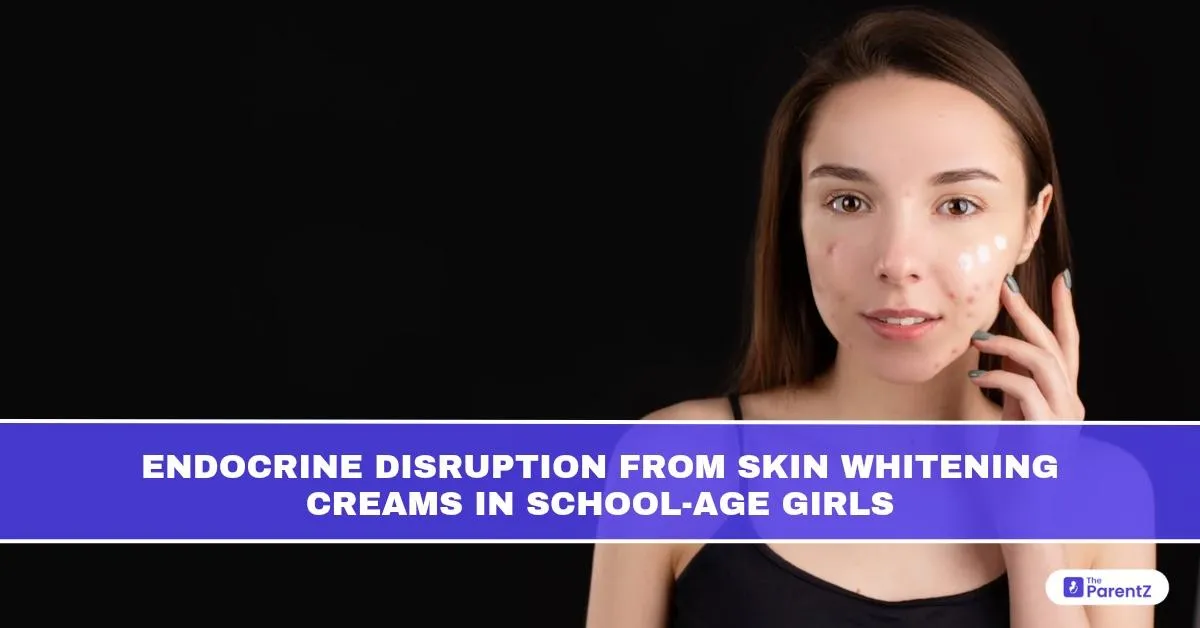In many parts of the world, including India, the pressure to meet certain beauty standards begins at a shockingly young age. Skin whitening creams, often marketed subtly to parents or teenage girls, are increasingly being used by school-age children sometimes without fully understanding the risks.
Beyond the visible effects on skin tone, many of these products contain harmful chemicals that interfere with the body’s hormone systems. These are called endocrine-disrupting chemicals (EDCs). In growing girls, EDCs can interfere with puberty, menstruation, fertility, metabolism, and even brain development.
What Are Endocrine-Disrupting Chemicals (EDCs)?
EDCs are chemicals that mimic, block, or alter natural hormones in the body, especially estrogen, progesterone, and thyroid hormones. These substances can mislead the body into behaving as though it has too much or too little of a hormone, disrupting the normal balance essential for healthy development.
When absorbed through the skin, these chemicals bypass the liver’s detox system and enter the bloodstream directly, making topical exposure particularly dangerous in children.
Common EDCs Found in Skin Whitening Creams
- Mercury
- Hydroquinone
- Corticosteroids (like clobetasol or betamethasone)
- Parabens
- Phthalates and Fragrance Additives
How Does This Affect School-Age Girls?
Girls between 6 and 16 years are undergoing critical stages of growth, brain development, and hormonal maturation. Endocrine disruption during this time can have both immediate and long-term consequences.
1. Early Puberty (Precocious Puberty)
Some whitening products can mimic estrogen and signal the body to begin puberty earlier than normal. This may manifest as:
- Early breast development
- Pubic or underarm hair growth
- Early onset of periods (menarche before age 8)
- Emotional distress and poor body image
2. Irregular Menstrual Cycles
Chronic exposure to EDCs can interfere with the hypothalamic-pituitary-ovarian axis, leading to:
- Delayed or missed periods
- Heavy or painful menstruation
- Hormonal acne or hair growth
3. Fertility and Reproductive Health
Long-term disruption in hormone signalling during adolescence may impact:
- Ovarian development
- Egg quality
- Risk of polycystic ovary syndrome (PCOS) in later life
4. Psychological and Social Effects
Girls using fairness creams may develop:
- Poor self-esteem or body dysmorphia
- Anxiety around appearance or peer approval
- Internalized colorism or beauty-based self-worth
Why School-Age Girls Are More Vulnerable
- Absorptive Skin: Young skin is more permeable, allowing greater absorption of topical toxins.
- Immature Detox Systems: The liver and kidneys are still developing and may not eliminate toxins efficiently.
- Hormonal Sensitivity: Small disruptions during puberty can cause large-scale changes in growth and development.
- Societal Pressure: Beauty ideals around fairness are often internalized early, especially through media, school comparisons, or family bias.
How to Protect Your Child
1. Read Labels Rigorously
Avoid creams that list hydroquinone, steroids, mercury compounds, or artificial fragrance. Watch for vague terms like “spot removal,” “glow,” “brightening,” or “ayurvedic fairness” with no clear ingredient list.
2. Say No to Homemade Remedies Too
Turmeric, lemon juice, and besan may not be endocrine disruptors, but they can cause burning, irritation, or skin barrier damage, especially in delicate young skin.
3. Educate Without Shame
If your child wants to use fairness creams, understand the root of the insecurity. Talk about body positivity, media literacy, and the harm of colorist beauty standards.
4. Encourage Safe Skincare Habits
For school-age children, skincare should be simple:
- Mild soap or cleanser
- Moisturizer
- Sunscreen (if going outdoors) Avoid unnecessary cosmetics or facial products.
5. Spread Awareness in Schools
School counsellors, teachers, and parents’ groups should collaborate to prevent beauty-based bullying or peer pressure that drives young girls toward harmful products.
When to See a Doctor
Consult a pediatrician or pediatric endocrinologist if your daughter experiences:
- Unusually early puberty signs
- Sudden weight gain, facial hair, or acne
- Irregular or painful menstruation
- Darkening skin patches (possibly from steroid misuse)
- Unexplained fatigue or mood changes
A detailed history, hormone profile, and sometimes even a skin biopsy may be needed to evaluate EDC exposure and plan safe management.
Final Thoughts: Beauty Should Not Cost Health
The desire to care for one’s skin is natural even in children. But fairness creams are often wolves in sheep’s clothing, offering beauty while stealing health. When these products contain unregulated steroids, mercury, or hormone disruptors, they don’t just whiten the skin; they interfere with the body’s most sacred systems. As caregivers, we must prioritize safety, awareness, and emotional education.
Teach your child that their worth is not in the fairness of their skin but in the brightness of their spirit.
Let us raise girls who are not only beautiful but healthy, informed, and proud of who they are, just as they are.








Be the first one to comment on this story.